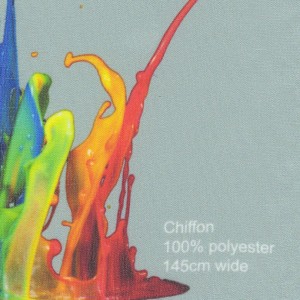Versatile, lightweight and with a luxurious look and feel, chiffon is a much-loved fabric.
In this post, we will give details about what Chiffon is, its origins, what makes a fabric Chiffon and suggestions for its end uses.
The History of Chiffon
The earliest incarnation of Chiffon as we know it today can be dated to 1938 when a nylon version of the fabric was invented, prior to that early Chiffon was made only from silk.

Then, 20 years later, a polyester Chiffon was devised and this brought greater resilience and a lower cost to this fabric, lifting it to another level.
The synthetic versions of Chiffon made it a fabric that becomes available to all, rather than the preserve of the rich and influential.
The name Chiffon is French and translates as ‘cloth’ or ‘rag’ though this literal translation is now outdated as it now refers to a sheer, luxurious, lustrous fabric that has the correct weave.
What Makes a Fabric Chiffon?
The weave for Chiffon is uniform pattern. The yarn – regardless of the material being used – is arranged in S and Z-shaped curves, these set opposing each other. A loom or industrial machine is then used to weave these together.
Even for industrial machines the process is not as fast as the creation of other fabrics, this because this is a process where damage can occur unless extreme care is taken.
The finished weave is plain balanced, this meaning that similarly weighted weft and warp threads are used.
To the end consumer, what does Chiffon look like?
It has a checkered effect, like a very fine mesh if studied carefully. It has a sheen and a lustrous appearance.
The Look and Feel of Chiffon
What really matters to those wearing or using items made of a fabric is the look and feel.
Chiffon has a slight translucency, this needs factoring into garments such as dresses, it is often used as an overlay, for instance when used over satin it creates a shimmery layer.
Chiffon is very lightweight, this quality is made use of in garments where there is a desire to add volume but not excess weight – for instance night dresses and evening dresses. Lots of gather can be incorporated and detail such as pleats flow and look light.
Chiffon is soft to the touch, but it also does not quite have a silk-like level of smoothness, instead there is a slight texture, this because the yarns are twisted in the production process.
It is always a fabric that flows, this incorporated into the design and uses – for instance, flowing dresses and headscarves, rather than being used for a garment that clings to the body
Colourful Chiffon
One huge benefit of Chiffon, why it is often chosen over other suitable fabrics, is that it takes dye brilliantly.
Bright, strong colours can be achieved easily and the nature of the fabric, the transplant quality, means that the print is almost doubled sided from printing on a single surface.
When a high-quality Digital printing technique is used, it is fully colourfast.
Uses for Chiffon
Chiffon is popular in dresses and scarves. Perhaps where it really stands apart is in digitally printed scarves, beautiful sarongs and head scarves.
Chiffon is also often used in display hangings and fashion items.
It is often a superb choice where a lightweight, luxurious, bright and vibrant look is desired. The fact that polyester has emerged as the leading choice for Chiffon also means that it has a durability that was once lacking, this making it suitable for those beautiful dresses for special occasions – they will withstand repeat wearing.
Chiffon is not typically used in items worn everyday, instead it is a beautiful, yet affordable option for items that get occasional wear, or items that add some glamour and style to an overall outfit.
Working with Chiffon
Chiffon is undeniably a fabric that has to be worked with carefully, but, contrary to what some might say, it is not difficult to work with.
When sewing, care must be taken not to pull the fabric as sewing and a new, sharp needle should be sued every time.
The lustrous nature also makes Chiffon a touch on the slippery side, and so sometimes people place sheets of paper on either side during sewing to ensure it remains in place – the paper then carefully ripped out on completion.
It is a fabric that should be worked with carefully, but this true of any fabric used to make luxurious, lightweight garments and accessories.
Custom Rain for Chiffon
At Custom Rain, we have the highest quality of HD digital printing and work with Chiffon to create stunning Garments and items for clients.
We have produced items for Olympic Games opening ceremonies, the BBC and numerous world-renowned brands. Equally, we work with individuals and small businesses, with small minimum order sizes.
Fabric swatches are available as a free service – please simply request up to 10 swatches in the fabrics of choice.
